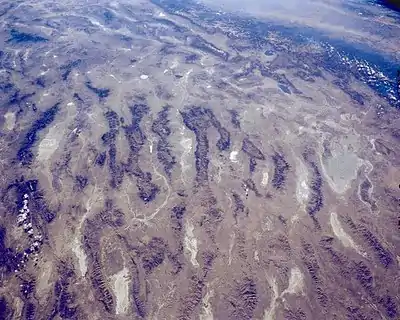Basin and range topography
Basin and range topography is an alternating landscape of parallel mountain ranges and valleys. It is a result of crustal extension/stretching (extensional tectonics) of the lithosphere (crust and upper mantle) due to mantle upwelling, gravitational collapse, crustal thickening, or relaxation of confining stresses.[1][2] Crustal extension causes the thinning and deformation of the upper crust in an orientation perpendicular to the direction of extension. As the plates pull apart, they thin allowing the hot mantle to rise close to the surface.[3] When the crust is extended it fractures along a fault plane, creating a series of long parallel normal faults. Between these normal faults are blocks, which subside, get uplifted or tilted. This is known as block faulting. Basins are formed due to subsidence of a block, while the blocks adjacent to the subsidence gets uplifted creating ranges. Normal faults are on both sides of the blocks; creating alternating elevated or subsided blocks, otherwise known as horst and graben. Basins and ranges can also be formed by blocks that are tilted causing one side to subside while the other side gets uplifted. These only have one side with a normal fault, this is known as tilted block faulting. Extension causes the plate to stretch, fracture and thin. Mountains rise and valleys drop, over a long period of time creating what we see as basin and range topography.

Clarence Dutton, an early pioneering geologist, described the basin and range topography of parallel mountains and valleys as "army of caterpillars marching toward Mexico."[4]
Types of faulting
Symmetrical faulting: horst and graben
With crustal extension, a series of normal faults which occur in groups, form in close proximity and dipping in opposite directions.[5] As the crust extends it fractures in series of fault planes, some blocks sink down due to gravity, creating long linear valleys or basins also known as grabens. While the blocks remaining up or uplifted produce mountains or ranges, also known as horsts. Fault scarps are exposed on the horst block and expose the footwall of the normal fault. This is a type of block faulting known as grabens and horsts. This basin and range topography is symmetrical having equal slopes on both sides of the valleys and mountain ranges.
Asymmetric faulting: tilted block faulting
Tilted block faulting, also known as half-graben or rotational block faulting, can also occur during extension. Large gently dipping normal faults, also known as detachment faults, acts as platform in which normal faulted blocks, tilt or slide along. However, instead of the whole block subsiding only one side if the block will slip along the detachment fault, tilting toward the fault plane. Again creating mountains (ranges) and valleys (basins). Many tilted slightly in one direction at their tops due to the motion of their bottoms along the main detachment fault. This basin and range topography has one steep side and the other is more gradual.
Mapping extension
One of the most studied basin and range topographies is the Basin and Range Province in the western United States, located between the Sierra Nevada and the Rocky Mountains. The extension of the province was believed to have begun in the late Cenozoic Era,[6] roughly 20 Ma. During the 90s scientists used a network of Global Positioning System (GPS) to determine the velocity magnitude and vector orientations of the Basin and Range province.[7] In the study by Thatcher et al. they discovered that most deformation was happening in the west, adjacent to the Sierra Nevada block and while less deformation was happening in the east. Because the extension of the basin and range hits the Sierra Nevada batholith, it essentially is hitting a solid wall, therefore the strain is transferred to smaller faults along the eastern side of the Sierra Nevada.[8] That might account for the slight northwestern extension in the northern part of the Basin and Range province.
See also
References
- Gans, P. B., & Miller, E. L. "Extension of the Basin and Range Province: Late orogenic collapse or something else?". Retrieved May 11, 2017.CS1 maint: multiple names: authors list (link)
- Liu, M., Shenm, Y. (1998). "Crustal collapse, mantle upwelling, and cenozoic extension in the north american cordillera". Tectonics. 17 (2): 311–321. Bibcode:1998Tecto..17..311L. doi:10.1029/98tc00313.CS1 maint: multiple names: authors list (link)
- Scott, Nicolle (April 17, 2012). "The Basin and Range Province of the United States". Emporia State University.
- Reynolds, D., & Christensen, J. (2001). Nevada. Portland, Or: Graphic Arts Center Pub.CS1 maint: multiple names: authors list (link)
- Hutson, P., Middleton, J., Miller, D., & Wallenstein, A. "Structures of Sedimentary Basins".CS1 maint: multiple names: authors list (link)
- Thompson, G. A., and Burke, D. B. (1974). "Regional geophysics of the Basin and Range Province". Annual Review of Earth and Planetary Sciences. 2: 213–238. doi:10.1146/annurev.ea.02.050174.001241.CS1 maint: multiple names: authors list (link)
- Thatcher, W., Foulger, G., Julian, B., Svarc, J., Quilty, E., & Bawden, G. (1999). "Present-Day Deformation Across the Basin and Range Province, Western United States". Science. 283 (5408): 1714–1718. Bibcode:1999Sci...283.1714T. doi:10.1126/science.283.5408.1714.CS1 maint: multiple names: authors list (link)
- Unruh, J., Humphrey, J., & Barron, A. (2003). "Transtensional model for the Sierra Nevada frontal fault system, eastern California". Geology. 31 (4): 327. Bibcode:2003Geo....31..327U. doi:10.1130/0091-7613(2003)031<0327:tmftsn>2.0.co;2.CS1 maint: multiple names: authors list (link)
- Encyclopædia Britannica
- Hutson, P., Middleton, J., Miller, D., & Wallenstein, A. "Examples of Sedimentary Basins: The Turpan Basin". www.geosci.usyd.edu.au. Retrieved 2017-05-12.CS1 maint: multiple names: authors list (link)
